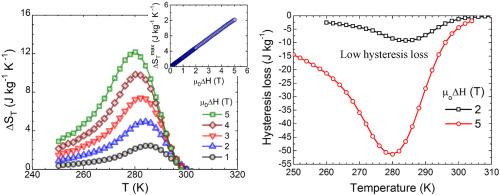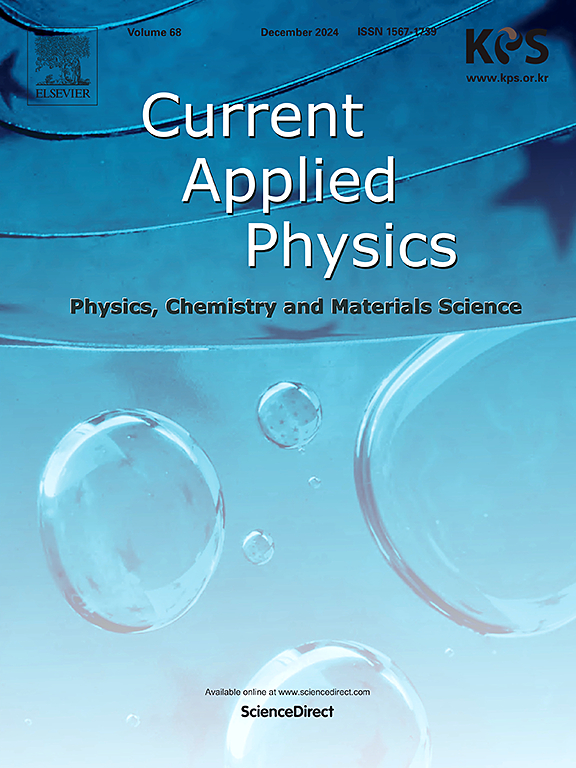Low hysteresis loss and moderate magnetic entropy change near room temperature in the bulk Ni39Co7Mn43Sn7Ti4 alloy
IF 3.1
4区 物理与天体物理
Q3 MATERIALS SCIENCE, MULTIDISCIPLINARY
引用次数: 0
Abstract
Ni-Co-Mn-Sn alloys with a significant magnetocaloric effect are considered promising candidates for room-temperature magnetic refrigeration. Alloying serves as an effective method to tune the working temperature and magnetocaloric properties of Ni-Co-Mn-Sn alloys. Here, we report the phase transformation and magnetocaloric properties of polycrystalline Ni39Co7Mn43Sn7Ti4 by alloying with a relatively high Ti content. This alloy displays a first-order martensitic transformation (MT) near room temperature and a second-order magnetic transition in austenite at 366 K. The application of a magnetic field significantly widened the temperature range of the MT, thereby contributing to a substantial effective refrigeration capacity of 198 J kg−1 at a magnetic field change of 5 T. Moreover, the alloy exhibits simultaneously a moderate isothermal magnetic entropy change (12.2 J kg−1 K−1) and a low average hysteresis loss (40 J kg−1) due to the weakened magnetic field-induced reverse martensitic transformation caused by Ti alloying.

Ni39Co7Mn43Sn7Ti4块体合金在室温附近磁滞损失低,磁熵变化适中
具有显著磁热效应的Ni-Co-Mn-Sn合金被认为是室温磁制冷的有希望的候选材料。合金化是调节Ni-Co-Mn-Sn合金工作温度和磁热性能的有效方法。本文报道了采用较高Ti含量合金制备Ni39Co7Mn43Sn7Ti4多晶的相变和磁热性能。该合金在室温附近表现为一阶马氏体相变,在366 K时表现为二阶奥氏体磁转变。磁场的施加显著地扩大了MT的温度范围,从而在5 t的磁场变化下获得了198 J kg−1的有效制冷能力。此外,由于Ti合金化引起的磁场诱导的反向马氏体相变减弱,合金同时表现出中等的等温磁熵变化(12.2 J kg−1 K−1)和较低的平均磁滞损失(40 J kg−1)。
本文章由计算机程序翻译,如有差异,请以英文原文为准。
求助全文
约1分钟内获得全文
求助全文
来源期刊

Current Applied Physics
物理-材料科学:综合
CiteScore
4.80
自引率
0.00%
发文量
213
审稿时长
33 days
期刊介绍:
Current Applied Physics (Curr. Appl. Phys.) is a monthly published international journal covering all the fields of applied science investigating the physics of the advanced materials for future applications.
Other areas covered: Experimental and theoretical aspects of advanced materials and devices dealing with synthesis or structural chemistry, physical and electronic properties, photonics, engineering applications, and uniquely pertinent measurement or analytical techniques.
Current Applied Physics, published since 2001, covers physics, chemistry and materials science, including bio-materials, with their engineering aspects. It is a truly interdisciplinary journal opening a forum for scientists of all related fields, a unique point of the journal discriminating it from other worldwide and/or Pacific Rim applied physics journals.
Regular research papers, letters and review articles with contents meeting the scope of the journal will be considered for publication after peer review.
The Journal is owned by the Korean Physical Society.
 求助内容:
求助内容: 应助结果提醒方式:
应助结果提醒方式:


